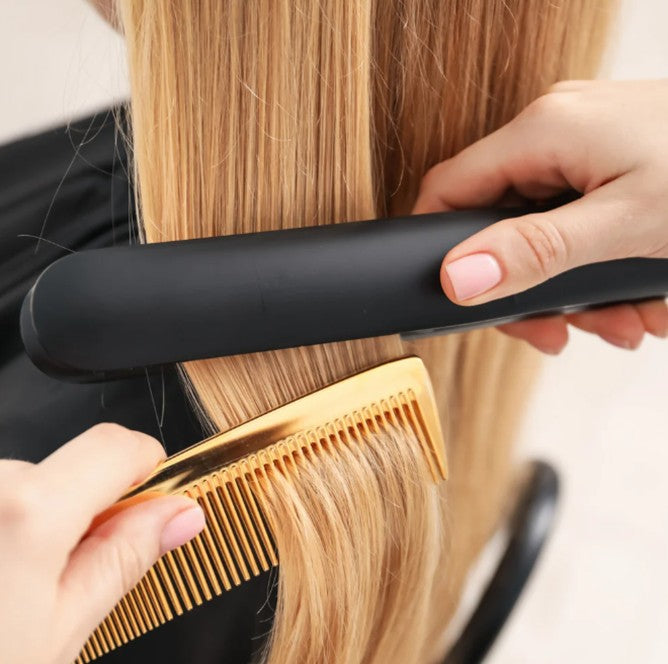How To Detangle Clip In Hair Extensions
by HEATHER COLLIER / 21 FÉVR. 2025
Reading Time: 4 Minutes
Index
Whether you have textured curly hair or the sleekest of straight hair, you will have to deal with tangles from time to time, and having to detangle clip in extensions is no exception. Surprisingly, many people make the common mistake of replacing their extensions way before they actually need to, due to difficulty removing knots and matting.
Clip in hair extensions are a fabulous way to add length and volume to your hair without the commitment of permanent extensions, so why not give them a second chance? In today’s blog, we’ll be diving into all the essentials of detangling your clip ins and maintaining their silky smoothness so you can maximise their use and keep them in pristine condition!

Just like our own hair, extensions can become matted if not cared for correctly or when they have been exposed to harsh elements. Matted hair will be difficult to brush and style, it will also feel dry and brittle and can seem impossible to fix. The good news is even the worst tangles can usually be removed and restored to their original beauty with a little help from the correct products and tools. To find out how to correctly care for hair extensions check out our ultimate guide.
Why Are My Clip In Extensions Tangling?

Understanding why your clip in hair extensions might tangle is the first step in preventing it. Several factors can contribute to this issue:
Quality of hair extensions:
Opting for high-quality Remy hair extensions can significantly reduce tangling. Our Remy hair maintains the natural alignment of hair cuticles, ensuring a smoother and less tangle-prone experience, while synthetic extensions and un-Remy options are more prone to matting.
Improper storage:
Storing your clip in extensions haphazardly can lead to unnecessary tangling. To keep them pristine, use our dedicated hair extension hanger and carrier. This ensures they remain organised and tangle-free.
Lack of maintenance:
Just like natural hair, extensions need regular care. Neglecting to brush them or using the wrong products such as round brushes or excessive heat styling can lead to matting and tangling.
Environmental factors:
Exposure to wind, humidity, or friction from clothing can cause tangles. Being mindful of these factors and taking preventive measures can help maintain the smoothness of your extensions.
How to Detangle Matted Hair Extensions
Dealing with matted hair extensions can be daunting, but with the right approach, you can restore them to their former glory. Here's a step-by-step guide:
- Separate hair into sections: Begin by dividing the hair into manageable sections with a pintail comb. This makes the detangling process more organised and less overwhelming.
- Start from the ends: Always begin brushing from the ends of the hair, gradually working your way up to the roots. This method minimises breakage and reduces stress on the hair shafts.
- Use a detangling spray or conditioner: Apply a quality detangling spray or a leave in conditioner to the matted areas. This helps to loosen the knots and makes the hair more pliable.
- Be gentle: Use a gentle, steady motion to work through the tangles. Patience is key to preventing damage!
- Hair Extension Holder: Place your clip ins into our easy-to-use hair extension holder, where you can place multiple wefts into its fine-toothed grip and brush and style seamlessly, making the process far easier and safer than detangling while still clipped into your natural hair.
For best results, use a hair extension brush designed specifically for Remy hair extensions. These brushes are crafted to glide through hair smoothly, reducing the risk of breakage.
Can You Brush Wet Hair?

Its true that wet hair is more susceptible to breakage due to its increased elasticity. However, if your hair extensions become knotty and tangled during washing, not brushing them before you dry them could cause the knots to worsen and become matts which is more damaging. We recommend gently brushing your clip in hair extensions with the correct brush whilst the conditioner is on to prevent any tangles forming.
Our detangling brush has flexible bristles that gently detangle without causing damage, making it safe to use on wet clip ins and permanent hair extensions. Always ensure to brush gently and avoid pulling or tugging to maintain the integrity of your extensions.
Tips to Prevent Tangling
Prevention is always better than cure. Here are some tips to keep your clip-in hair extensions tangle-free:
Regular brushing:
Incorporate regular brushing into your hair care routine with our extension-friendly detangling hairbrush. This brush can be used on wet and dry hair and helps to prevent tangles from forming in the first place. Section your hair with alligator clips while brushing to make the process easier, especially when distinguishing which areas need more attention.

Use the right products:
Opt for our sulphate-free shampoo and conditioner to maintain the health of your extensions. Sulphates can strip the hair of its natural oils, leading to dryness and increased tangling.

Proper storage:
Using our hair extension hanger and carrier ensures your extensions are stored correctly, reducing the risk of tangling.

Avoid sleeping with extensions in:
Always remove your clip in extensions before bed to prevent matting.

Be mindful of activities:
Activities like swimming or intense workouts can expose your extensions to sweat and chlorine, which can cause tangling. Consider removing them during such activities or take protective measures.

Conclusion:
By following these guidelines and incorporating the right tools and products into your routine, you can keep your clip-in hair extensions looking fabulous and tangle-free without having to replace them! For more info on our clip in collection, you can browse our latest guide Clip In Hair Extensions Explained.
FAQs
Quelles sont les meilleures techniques pour démêler les extensions de cheveux de clip-in?
Démêler clip-in hair extensions Effectivement, commencez par les brosser doucement des extrémités aux racines en utilisant un extension-friendly, detangling hairbrush. Tenez fermement les extensions à la base de clip pour éviter de tirer les clips eux-mêmes. Utilisez un spray ou un revitalisant démêlant pour aider à desserrer les nœuds et les enchevêtrements avant le brossage. Travaillez toujours en petites sections et soyez patient pour éviter d'endommager les fibres capillaires.
Quels outils dois-je utiliser pour éviter les extensions de cheveux de clip-in dommageables pendant le démêlage?
Notre detangling hairbrush Est parfaitement conçu pour démêler les extensions naturelles des cheveux et des cheveux - l'indice est dans le nom! Ses poils doux glissent sans effort dans vos tresses, et lorsqu'ils sont combinés avec notre poignée antidérapante, vous serez garanti de zéro enchevêtrement et de zéro dommages.
Y a-t-il des produits spécifiques qui peuvent aider à démêler les extensions de cheveux à clip-in?
Oui, plusieurs produits sont spécialement conçus pour aider à démêler clip-in hair extensions Efficacement. Recherchez des sprays démêlant, des conditionneurs sans rinçage ou Cliphair’s detangling hairbrush. Ces produits contiennent souvent des ingrédients comme le silicone ou les huiles qui fournissent un glissement et réduisent les frictions, ce qui facilite le brossage des enchevêtrements doucement. Optez pour des produits qui conviennent à la fois pour les extensions naturelles des cheveux et des cheveux, selon le type que vous avez.
À quelle fréquence dois-je démêler mes extensions de cheveux de clip-in pour maintenir leur qualité?
Détectez votre clip in extensions Avant le lavage et avant et après chaque utilisation. Si vous remarquez que vos cheveux deviennent noueux pendant que vous les portez, il est préférable de se brosser immédiatement, surtout par temps venteux ou humide pour éviter les nattes.
À quelle fréquence dois-je brosser mon clip dans des extensions de cheveux?
Il est conseillé de brosser vos extensions avant et après chaque utilisation. Le brossage régulier aide à maintenir leur douceur et empêche l'entrée.
Puis-je utiliser des brosses à cheveux régulières sur mes extensions?
Toutes les brosses à cheveux ne conviennent pas aux extensions de cheveux, il est préférable d'utiliser un pinceau spécialement conçu pour les extensions. Les brosses avec des bobbles aux extrémités des dents peuvent attraper les accessoires provoquant un glissement et une tension sur le cuir chevelu. Il est préférable d'utiliser un pinceau d'extension de cheveux conçu spécifiquement pour clip in Et professional hair extensions. Ces pinceaux sont plus doux et aident à maintenir l'intégrité des cheveux.
Quels produits dois-je éviter pour empêcher mes extensions de s'emmêler?
Évitez d'utiliser des produits contenant des sulfates et de l'alcool. Notre Quench The Thirst haircare collection Contient zéro sulfates, parabènes et alcool, et reste sûr pour une utilisation sur les extensions naturelles des cheveux et des cheveux. Optez pour des produits hydratants et sans sulfate pour garder vos extensions hydratées et lisses.
Comment dois-je stocker mon clip dans des extensions de cheveux?
Conservez-les dans un endroit frais et sec comme notre satiné hanger and carrier Pour les garder organisés, sans enchevêtrement et loin de l'humidité et de la poussière.
Puis-je dormir avec mes extensions de clip-in?
Il est recommandé d'éliminer les extensions de clip-in avant de dormir pour éviter l'empinet et les nattes, car cela peut endommager à la fois vos extensions et vos cheveux naturels.
Comment faire revivre les extensions gravement emmêlées?
Pour les nattes sévères, envisagez d'appliquer un deep conditioning treatment Et se démêlant doucement avec un wide tooth comb. Si le tapis persiste, il peut être préférable de consulter un styliste professionnel qui se spécialise dans l'application ou la restauration des extensions de cheveux humains.
Looking for flawless, salon-worthy hair without breaking the bank? At Cliphair, we’ve got you covered with luxurious clip in hair extensions for quick transformations and permanent hair extensions for long-lasting glam. Extensions require special care and maintenance to preserve their quality, which is why we have all the top-notch hydrating haircare products needed to keep your style on point.
Need the perfect shade? Browse our full range of human hair extensions in over 70 rich, silky shades or check out our FREE Express Color Match Service to ensure a seamless blend every time.






